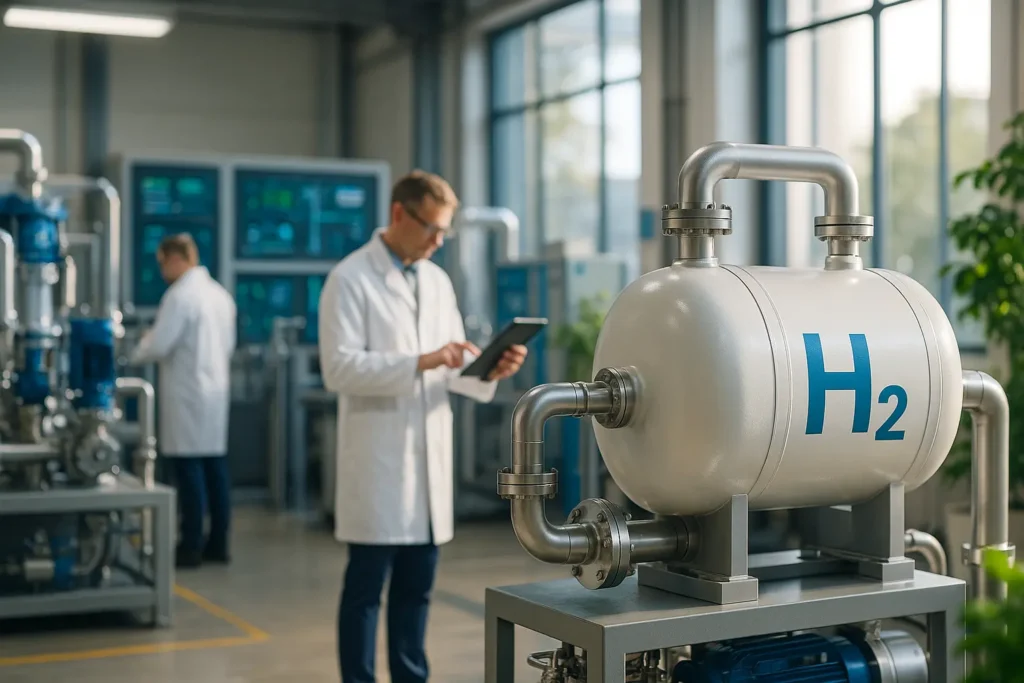A pivotal shift is currently underway in the heart of Europe‘s industrial sector, and it’s described in one word: hydrogen. As we stand on the precipice of a global energy revolution, the European Commission is spearheading a bold agenda to transition towards cleaner energy sources. The need to curb carbon emissions and combat climate change is driving industries to reconsider their traditional fuel sources. This is where the green energy potential of hydrogen comes into play.
Hydrogen, once merely a niche topic among scientists, is now being hailed as the fuel of the future. In this article, we delve into why European manufacturing is embracing hydrogen in its strategy to transform the industry, reduce reliance on fossil fuels, and meet the growing demand for clean energy.
Hydrogen: The Game-Changer in Energy Production
Let’s begin with the fundamentals. Hydrogen is the most abundant element in the universe, yet its utility as an energy source is largely untapped. Unlike fossil fuels, hydrogen offers a clear path toward renewable energy solutions. To understand the allure of hydrogen, we must consider its attributes: it’s the lightest element, has a high energy content by weight, and, most importantly, when used as a fuel, produces zero direct carbon emissions.
In a global push to decarbonize, hydrogen provides an opportunity to revolutionize energy production. For Europe, which aims to lead the charge against climate change, this is a pivotal moment. The ability of hydrogen to act as a clean energy carrier is invaluable for sectors like manufacturing, which are traditionally energy-intensive.
While significant technological challenges remain, the potential for hydrogen to fill the energy gap left by diminishing gas and coal supplies is driving massive investments. Across Europe, pilot projects are underway to enhance hydrogen’s efficiency and integration into existing energy infrastructures. These projects are not just European endeavors but part of a broader, global movement towards sustainable energy systems.
The Role of the European Commission in Driving Hydrogen Projects
No discussion about hydrogen’s rise in Europe would be complete without acknowledging the pivotal role of the European Commission. The Commission’s ambitious policies and financial backing have set the stage for hydrogen’s ascent within the European energy landscape. By crafting a cohesive framework to support hydrogen projects, the Commission aims to secure a clean energy future for all.
Significant funding has been allocated to research and development, with a focus on making hydrogen economically viable and widely accessible. This investment underscores the Commission’s commitment to not only meeting, but exceeding, global climate targets.
The Commission’s strategy is clear: promote hydrogen as a central component of the energy transition. It seeks to establish a strong hydrogen market, reduce carbon intensity in industries, and ultimately, assist in the European Union’s climate goals. As hydrogen projects proliferate, they are expected to generate an influx of jobs, bolster economic growth, and secure a stable energy supply, further solidifying Europe’s leadership in the green energy sector.
Manufacturing and the Shift Towards Green Hydrogen
The manufacturing sector stands at a crossroads. Historically reliant on fossil fuels, manufacturers are now pivoting towards green hydrogen to align with the European Union’s ambitious climate targets. This transition is essential not only for environmental sustainability but also for the industry’s long-term viability.
Green hydrogen, produced through renewable energy sources like wind and solar, is poised to fill the void left by traditional fuels. As manufacturing processes continue to evolve, the need for a reliable, clean, and cost-effective energy source becomes paramount. Hydrogen’s adaptability allows it to be used across various stages of production, providing industries with the flexibility they need.
Innovation is at the heart of this shift. Companies are investing in cutting-edge technology to harness hydrogen more efficiently, ensuring that it complements the existing energy mix. As hydrogen infrastructure develops, we anticipate a reduction in costs, making it a more attractive option for manufacturers.
Moreover, transitioning to hydrogen aligns with the broader global movements towards sustainability, ensuring that European manufacturers remain competitive on the world stage. This shift is not just about reducing emissions; it’s about redefining what it means to be an industry leader in the 21st century.
Challenges and Opportunities on the Horizon
While the promise of hydrogen is enticing, we must acknowledge the inevitable challenges. The transition to hydrogen-based energy systems will require significant investment and innovation. Infrastructure development, supply chain logistics, and market acceptance are just a few of the obstacles that lie ahead.
Yet, with challenges come opportunities. The potential for hydrogen to transform industries is vast. By filling the energy gap left by fossil fuels, hydrogen can drive Europe towards a carbon-neutral future. The decoupling of economic growth from carbon emissions is achievable if we harness hydrogen’s potential effectively.
Furthermore, the global focus on sustainability is creating a favorable environment for hydrogen adoption. As more countries commit to reducing their carbon footprints, the demand for clean energy solutions will inevitably increase. Europe, with its proactive policies and innovative spirit, is well-positioned to lead this global energy transition.
In conclusion, while the path forward is fraught with challenges, the potential rewards are substantial. Embracing hydrogen could redefine the energy landscape, offering a cleaner, more sustainable future.
The march towards a hydrogen-driven future is unmistakable. For European manufacturing, this shift represents more than just an energy transition; it’s a profound evolution in how we view and utilize resources. As hydrogen steps into the limelight, it holds the potential to reshape industries, reduce reliance on fossil fuels, and propel us into a new era of clean energy.
By embracing hydrogen, we’re not just investing in a fuel source; we’re investing in a sustainable future that aligns with our global climate objectives. The road may be long and challenging, but with strategic planning, innovation, and perseverance, Europe can lead the world in this energy revolution. Hydrogen is not just the fuel of the future—it’s the catalyst for transformative change.
FAQ
What factors are driving European manufacturers to adopt hydrogen as a key energy source?
European manufacturers are turning to hydrogen due to its potential to significantly reduce carbon emissions, align with stringent EU environmental regulations, and enhance energy independence by reducing reliance on fossil fuels.
How does hydrogen energy contribute to reducing the carbon footprint of manufacturing processes?
Hydrogen, when used as a fuel, produces only water vapor as a byproduct, thus eliminating carbon dioxide emissions. This makes it an attractive option for manufacturers seeking to lower their carbon footprint and meet sustainable development goals.
What are the primary challenges facing the implementation of hydrogen technology in European manufacturing?
The main challenges include the high costs associated with hydrogen production, the need for extensive infrastructure development, and the current lack of widespread availability of hydrogen technology.
In what ways are European governments supporting the transition to hydrogen-based manufacturing?
European governments are offering incentives such as grants and subsidies, investing in research and development, and establishing regulatory frameworks to facilitate the integration of hydrogen into the manufacturing sector.
What impact is the shift to hydrogen expected to have on the competitiveness of European manufacturing globally?
By adopting hydrogen technology, European manufacturers can position themselves as leaders in sustainable production, potentially gaining a competitive edge in international markets that increasingly prioritize environmentally friendly practices.



